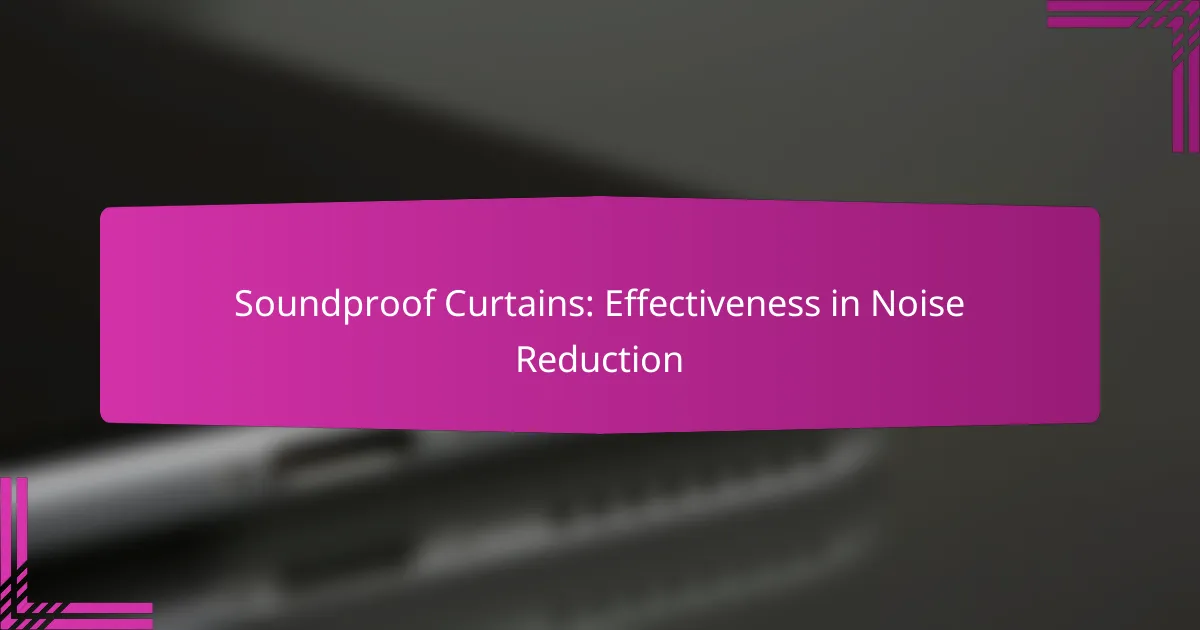Soundproof curtains are an effective solution for reducing noise levels in your home, utilizing heavy materials to absorb sound waves and block external disturbances. Installing them yourself can enhance your living space’s privacy and energy efficiency while creating a more peaceful environment. With the right tools and a bit of guidance, even beginners can achieve a successful DIY installation.

How do soundproof curtains work?
Soundproof curtains work by reducing noise levels in a space through a combination of sound absorption and noise transmission reduction. They are designed with heavy, dense materials that help block and absorb sound waves, making them effective for minimizing external noise disturbances.
Absorption of sound waves
Soundproof curtains absorb sound waves by utilizing thick, heavy fabrics that dampen vibrations. When sound waves hit the curtain, the material’s density helps to convert sound energy into a small amount of heat, effectively reducing the sound that passes through. This absorption is particularly effective for high-frequency sounds, such as voices or traffic noise.
To maximize sound absorption, look for curtains with multiple layers or specialized acoustic materials. The more layers and density, the better the absorption capabilities, which can significantly improve the overall sound quality in a room.
Reduction of noise transmission
In addition to absorbing sound, soundproof curtains also reduce noise transmission by acting as a barrier. The heavy fabric blocks sound waves from entering or leaving a space, which is especially useful in urban environments or near busy roads. This barrier effect can lower the decibel levels of external noise considerably.
For optimal noise reduction, ensure that the curtains cover the entire window area and extend beyond the edges. This prevents sound from sneaking around the sides and enhances the overall effectiveness of the curtains.
Material properties
The material properties of soundproof curtains are crucial for their performance. Look for fabrics such as polyester, velvet, or specially designed acoustic materials that have high density. These materials not only block sound but also provide insulation, which can help maintain room temperature.
When selecting soundproof curtains, consider the weight and thickness of the fabric. Heavier curtains, typically weighing over 300 grams per square meter, tend to offer better soundproofing capabilities. Additionally, curtains with a tight weave can further enhance sound absorption and noise reduction.

What are the benefits of soundproof curtains?
Soundproof curtains provide several advantages, including noise reduction, enhanced privacy, and improved energy efficiency. They are designed to absorb sound waves, making them effective in minimizing external noise and creating a more peaceful indoor environment.
Improved privacy
Soundproof curtains enhance privacy by blocking sound from entering or leaving a room. This is particularly beneficial in urban areas or shared living spaces where noise can disrupt personal activities or conversations.
When selecting soundproof curtains, look for options with a high density and thick fabric, as these materials are more effective at muffling sound. Ensure that the curtains cover the entire window area to maximize their privacy benefits.
Enhanced comfort
By reducing noise levels, soundproof curtains contribute to a more comfortable living space. They help create a serene atmosphere, which can improve focus and relaxation, especially in busy environments.
To achieve the best comfort level, consider layering soundproof curtains with blackout curtains. This combination not only blocks sound but also light, further enhancing your indoor comfort.
Energy efficiency
Soundproof curtains can improve energy efficiency by providing insulation against temperature fluctuations. They help keep rooms warmer in winter and cooler in summer, potentially reducing heating and cooling costs.
For optimal energy savings, choose curtains with thermal lining. This added layer enhances insulation properties, making your home more energy-efficient while also contributing to soundproofing.

What tools do I need for DIY installation?
For DIY installation of soundproof curtains, you will need a few essential tools to ensure a smooth process. These tools include a measuring tape, a drill with screws, and a level along with brackets for proper hanging.
Measuring tape
A measuring tape is crucial for accurately determining the width and height of your window. Measure from the top of the window frame to where you want the curtains to hang, ensuring you account for any additional length needed for soundproofing.
When measuring the width, consider extending the curtain rod beyond the window frame to block more sound. A common practice is to add at least 15-30 cm on each side for optimal coverage.
Drill and screws
A drill is necessary for installing brackets securely into the wall. Choose a drill that matches the size of the screws you will be using, typically around 3-5 cm long for standard brackets.
Make sure to use wall anchors if you are drilling into drywall to provide extra support. This will help prevent the brackets from pulling out over time, especially with heavier soundproof curtains.
Level and brackets
A level ensures that your curtain rod is hung straight, which is essential for both aesthetics and functionality. Use a standard bubble level to check the alignment before securing the brackets.
Brackets come in various styles and materials, so choose ones that can support the weight of your soundproof curtains. Metal brackets are often more durable than plastic options, making them a better choice for heavier fabrics.

What are the steps for installing soundproof curtains?
Installing soundproof curtains involves a few straightforward steps that ensure they effectively reduce noise. Proper measurement, selection of curtain length, and installation of the curtain rod are essential for optimal performance.
Step 1: Measure window dimensions
Begin by accurately measuring the width and height of your windows. Use a tape measure to determine the exact dimensions, ensuring you measure from the top of the window frame to the desired length below the window. This will help you select the right size curtains for maximum coverage.
Consider measuring a few times to confirm accuracy, and note any obstructions like window handles or sills that might affect the curtain’s placement. A common practice is to add a few extra inches to the width for better light blocking and sound absorption.
Step 2: Choose the right curtain length
Selecting the appropriate curtain length is crucial for soundproofing effectiveness. Curtains that reach the floor or extend slightly beyond it can help minimize noise infiltration. Typically, lengths range from 84 inches to 108 inches, depending on your window height.
For a more dramatic effect, consider floor-to-ceiling curtains, which can enhance both soundproofing and aesthetics. Ensure the fabric is thick and heavy, as this contributes significantly to sound absorption.
Step 3: Install curtain rod
Installing the curtain rod correctly is vital for the stability and functionality of your soundproof curtains. Use brackets that can support the weight of heavy curtains, and install them at least 4-6 inches above the window frame to allow for full coverage.
Ensure the rod is level and securely fastened to the wall. If necessary, use wall anchors for added support. Once the rod is installed, hang the curtains and check for any gaps that could allow sound to enter, adjusting as needed for a snug fit.

How do I choose the right soundproof curtains?
Choosing the right soundproof curtains involves considering factors like material, thickness, and design. These elements will affect how well the curtains block sound and fit your home’s aesthetic.
Material options
Soundproof curtains are typically made from heavy fabrics such as polyester, velvet, or a blend of materials designed to absorb sound. Look for curtains labeled as soundproof or noise-reducing, as they often contain additional layers or special treatments to enhance sound insulation.
Some curtains also feature a backing made from foam or mass-loaded vinyl, which can significantly improve their sound-blocking capabilities. Consider your budget and the specific soundproofing needs of your space when selecting materials.
Thickness considerations
The thickness of soundproof curtains plays a crucial role in their effectiveness. Generally, thicker curtains provide better sound insulation, so aim for options that are at least 1 inch thick. However, very thick curtains may be heavier and require sturdier hardware for installation.
When assessing thickness, also consider the density of the fabric. A dense fabric will block more sound than a lightweight one, even if both are the same thickness. Look for curtains that combine both thickness and density for optimal results.
Color and design choices
While functionality is key, the color and design of soundproof curtains should complement your interior decor. Available in a wide range of colors and patterns, you can find options that enhance the aesthetic of your room while providing sound insulation.
When selecting colors, consider how they will interact with your existing furnishings and wall colors. Darker colors may absorb more sound and light, while lighter shades can brighten a space. Choose a design that reflects your style while still meeting your soundproofing needs.

